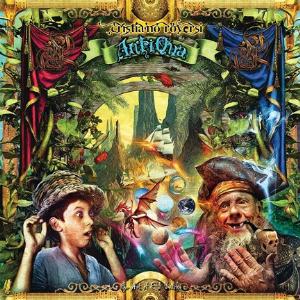While listening to Cristiano Roversi's latest solo album AntiQua, I had to think about one album in particular, namely the eponymous album recorded by Submarine Silence (2001). That's not strange at all because keyboardist Roversi (Moongarden, Mangala Vallis) was one of the three musicians who recorded that album, which was strongly influenced by the early Genesis. The others were David Cremoni (guitars) and Emilio Pizzoccoli (drums, percussion).
In a way the same style of music can be heard on the third album Cristiano Roversi recorded after his previous solo efforts Music From My Room's Window (1999) and The Park (2003). Mainly because of the use of the Mellotron, the acoustic piano and the sound of the electric and acoustic guitars take you back in time to the days when Genesis recorded albums as Trespass (1970) and Nursery Cryme (1971). The musicians who are mainly responsible for the beautiful guitar parts are David Cremoni (electric guitar on Crave Some Loneliness), Erik Montanari (acoustic guitar on Crave Some Loneliness and L'Amore) and Fabio Serra (electric guitar on Morning In AntiQua, East Or West?,Celestial Slowfall and AntiQua).
Of course, in some respects AntiQua differs from Submarine Silence. This time Roversi hardly used a drummer of flesh and blood. Only Gigi Cavalli Cocchi (Mangala Vallis) played some drums. The drum machine gets a main role and I have to admit that it hardly bothered me, because Roversi used it in a proper way. Another difference withSubmarine Silence is the use of three singers, namely Leonora (vocals and lyrics on Falling), Aldo Tagliapietra(vocals, lyrics and acoustic guitars on L'Amore) and Bernardo Lanzetti (vocals, lyrics and concept on Tales From Solitude). Thanks to their wonderful voices they provided the album a lot of variety.
Obviously Roversi played most of the instruments himself. He played the twelve-string, classical and electric guitar, the grand piano, various synthesizers, Taurus bass pedals, Polymoog, Mellotron, Hammond organ L100 and he programmed the Roland CR-78 drum machine. Apart from these instruments he used samples and Cinematic Efx. All tracks on this album are rather mellow and comprise a high level of musicality. The music is varied thanks to the above-mentioned singers and the beautiful solos performed on the electric guitar and the synths. The excellent string synthesizer parts, like for instance on Nessie Revealed, provide a strong ambient sound from time to time. On some of the tracks the musical style shifts in the direction of the acoustic albums recorded by Steve Hackettand Anthony Phillips. A good example is the second part of Falling called Celestial Slowfall, and Dimlit Tavern.
Alongside the beautiful music this album has been inserted in the amazing artwork of the well-known designer Ed Unitsky. AntiQua is highly recommended to those who enjoyed the early albums recorded by Genesis and the many acoustic albums recorded by Anthony Phillips and Steve Hackett, but especially to those who found the only album created by Submarine Silence a real beauty!
**** Henri Strik (edited by Peter Willemsen)



No comments:
Post a Comment